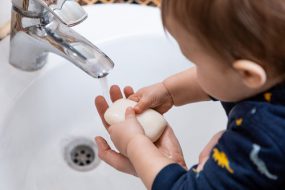Mealtime Routines and Tips

Routines can help children know what to expect when it is time for meals or snacks.
For more information, watch these videos from 1,000 Days.
Ready to feed your 6 to 24 month old? Mealtime can be a messy and fun learning experience. Your child may have about 3 meals and 2 to 3 snacks every day. Having a routine can help children know what to expect when it is time for meals or snacks.
Here are some routines and tips for mealtimes:
Clean
- Wash your child’s hands before mealtime.
- Tip: Worried about a mess? You can put newspaper or a plastic mat on the floor under your child’s high chair or booster seat. This can help with cleanup.
Be Safe
- Sit your child in a safe place. A high chair or booster seat are good options.
- Strap your child into the high chair or booster seat.
- Watch children at all times to make sure they are safe.
- Tip: Learn important food safety steps to keep your child safe from foodborne illness. Visit Foodsafety.gov or CDC’s page on Safer Food Choices for Children Under 5 Years Old.
Focus
- Face your child toward you or other family members at the table.
- Limit distractions. Avoid letting TV, videos, cell phones, or pets distract your child from eating. These can also distract you too. Focus on your child during mealtimes.
- Did You Know?
Children should not watch screens.
The American Academy of Pediatrics recommends children avoid using screens until they are 18 months old, unless video-chatting with friends or family.
See the reasons for this recommendation.
Talk with your child during mealtimes. This can be a fun time, and it is important for your child to have your attention.
- Tip: Mealtimes do not have to be long. Mealtimes can last 10 or 15 minutes, or for as long as your child can pay attention.
Fingers, spoons, forks, and cups
- When babies first starts eating foods, you may use a spoon or they may use their fingers.
- As children get older, they will develop different skills to help with mealtimes. Learn more about when children will begin to use their fingers, spoons, forks, and cups.
- Tip: Are you worried about breaking dishes or cups? Use dishes and cups that are not breakable and do not have sharp edges.
Family meals
Children may eat different amounts of food each day.
This is normal. Talk with your child’s doctor or nurse if you are concerned about how much, or how little, your child is eating.
- Sitting down as a family for mealtime can teach your child how to eat and helps your child develop social skills.
- Give your child healthy food options at each meal.
- Tip: Want your child to try new foods? Model healthy eating. It can help your child learn what to do.
Amount
- Let your child decide how much to eat. Your child does not have to finish all the food on the plate or drink all the liquid in the cup or bottle.
- Tip: Watch your children for signs that they are hungry or full.
